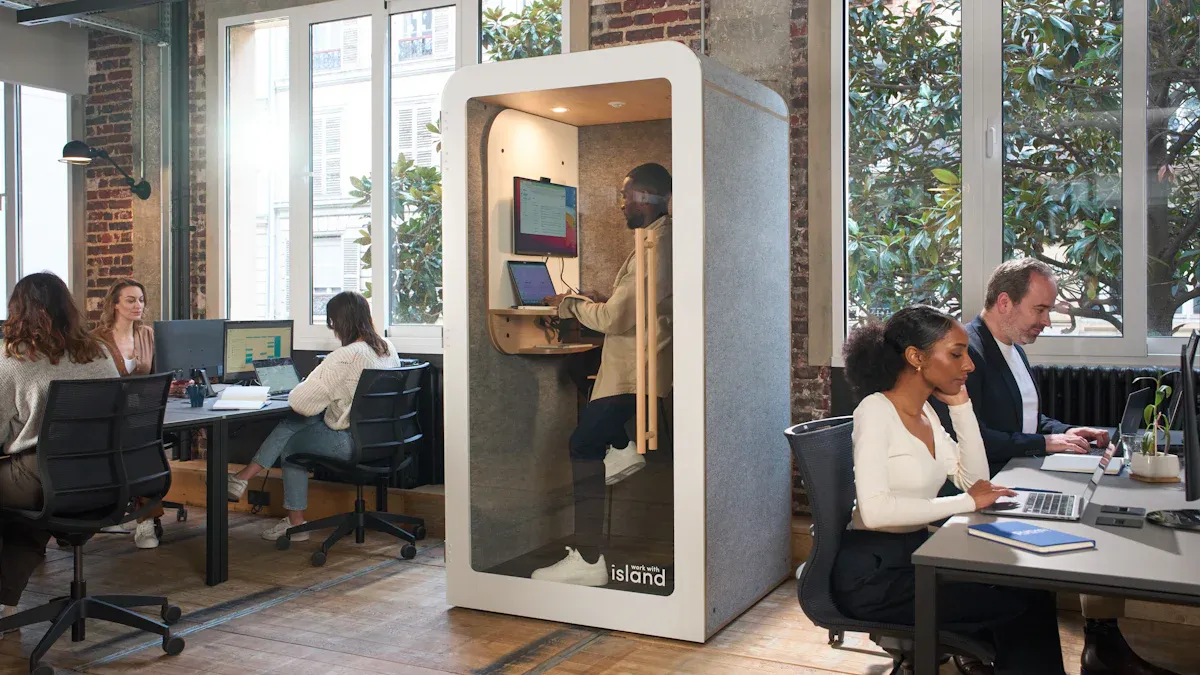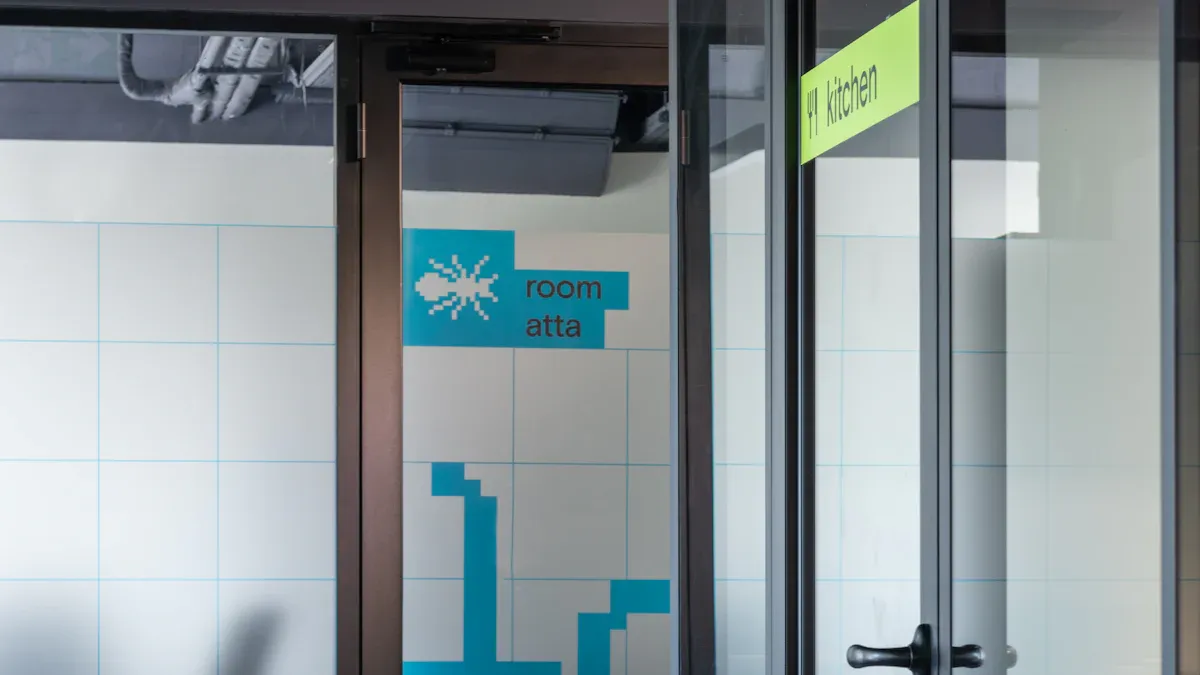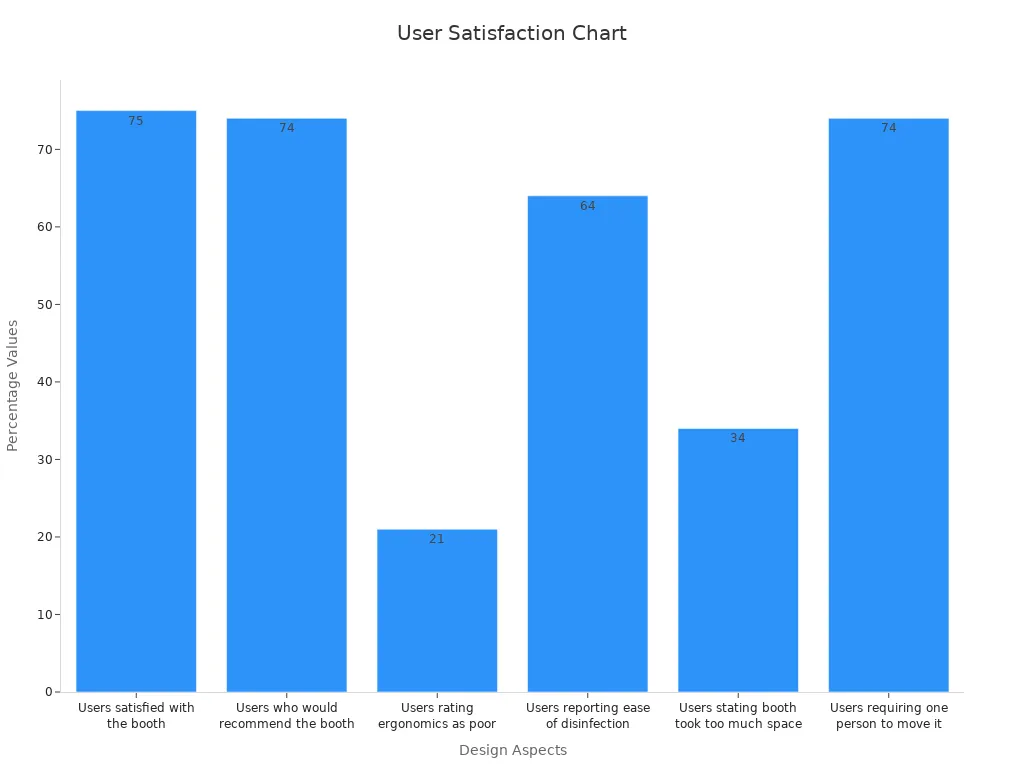
Phone booth cubicles excel in creating quiet spaces through their advanced soundproofing features. These booths reduce noise by 30 decibels on the Noise Isolation Class scale, ensuring minimal sound interference. In open office settings, they serve as distraction-free zones, allowing employees to focus better. Studies show improved productivity, satisfaction, and business outcomes when meeting pods for offices are utilized. Soundproof booths for offices also enhance concentration levels, fostering effective task immersion. The Multi-Function Silent Booth combines these benefits with ergonomic designs, making it a versatile solution for modern workplaces.
Materials That Make Phone Booth Cubicles Soundproof

Acoustic Panels for Noise Absorption
Acoustic panels play a critical role in enhancing the soundproofing capabilities of phone booth cubicles. These panels are designed to absorb sound waves, reducing echo and minimizing noise within the enclosed space. Advanced soundproofing technology, including micro-perforated panels (MPPs), has revolutionized noise absorption. MPPs achieve high absorption coefficients, such as 0.96 at 250 Hz and 0.98 at 400 Hz, making them highly effective in reducing noise across specific frequency ranges. Unlike conventional materials like mineral wool and fiberglass, which excel at high-frequency noise but struggle with low frequencies, MPPs offer tailored solutions for diverse acoustic needs.
To illustrate their performance, consider the following comparison of Noise Reduction Ratings (NRR) for popular products:
| Product | Noise Reduction Rating |
|---|---|
| ROOM Phone Booth | 30 dB |
| Kubebooth Pods | 36 dB |
These ratings highlight the superior noise absorption capabilities of acoustic panels, ensuring a quieter and more focused environment inside the cubicles.
Insulated Walls for Sound Blocking
Insulated walls are another essential component in the soundproofing of phone booth cubicles. These walls are constructed using multi-layered materials that block sound transmission effectively. For instance, hushHybrid booths demonstrate the ability to convert 70 dB of external noise into a significantly quieter ambient sound. This substantial reduction in sound leakage ensures that conversations inside the cubicle remain private and undisturbed by external noise.
Performance tests and acoustic simulations further validate the effectiveness of insulated walls. These tests systematically measure the acoustic quality of spaces, confirming that insulated walls provide robust sound-blocking capabilities. By incorporating high-density materials and advanced engineering, these walls create a barrier that prevents sound from escaping or entering the cubicle.
Sealed Doors and Windows for Noise Isolation
Sealed doors and windows are crucial for maintaining the acoustic integrity of phone booth cubicles. They prevent sound leakage by creating an airtight seal, which isolates the interior from external noise. High-quality seals, combined with double-glazed windows, enhance noise isolation while allowing natural light to enter the cubicle. This design not only improves soundproofing but also contributes to a comfortable and well-lit workspace.
The precision engineering of these components ensures that the cubicle remains a distraction-free zone. By eliminating gaps and weak points where sound could escape, sealed doors and windows enhance the overall effectiveness of the cubicle’s soundproofing system.
Design Features of Effective Phone Booth Cubicles

Enclosed Structure for Privacy
The enclosed structure of phone booth cubicles ensures privacy by minimizing sound leakage and external distractions. These cubicles are designed to reduce noise by 30 decibels on the Noise Isolation Class (NIC) scale, making them highly effective for confidential conversations. The materials used in the construction absorb and muffle external sounds, creating an ideal environment for phone and video calls. This design standard not only enhances acoustic performance but also fosters a sense of security for users engaging in sensitive discussions.
User satisfaction surveys further validate the effectiveness of enclosed structures. A significant percentage of users appreciate the privacy and soundproofing capabilities of these booths. The following table highlights key insights from user feedback:
| Aspect of Design | Percentage of Users | Comments on Satisfaction/Dissatisfaction |
|---|---|---|
| Users satisfied with the booth | 75% | Majority liked swabber protection (92%) |
| Users who would recommend the booth | 74% | Concerns about space and ergonomics |
| Users rating ergonomics as poor | 21% | Criticism on glove height and bulkiness |
| Users reporting ease of disinfection | 64% | |
| Users stating booth took too much space | 34% | |
| Users requiring one person to move it | 74% | Indicating mobility and ease of setup |

Silent Ventilation Systems
Silent ventilation systems are integral to the functionality of phone booth cubicles. These systems maintain airflow without compromising the acoustic integrity of the space. Products like the Private Work Pod adhere to ISO 23351-1:2020 standards, ensuring speech level reduction across a frequency range of 125 Hz to 8000 Hz. This certification highlights the ability of these systems to balance ventilation and soundproofing effectively.
The following table showcases the acoustic ratings of various phone booth cubicles equipped with silent ventilation systems:
| Product | Acoustic Rating |
|---|---|
| Private Work Pod | Frequency range 125 Hz to 8000 Hz according to ISO 23351-1:2020, Speech level reduction – DS,A 28.5 (dB) |
| The Phone Booth by ROOM | Sustainable soundproof walls that reduce noise by 28 decibels. |
| TalkZone by Spec Furniture Inc. | ISO 23351-1:2020 |
| WiggleRoom by KI | Db loss of 30. |
These systems ensure a comfortable and distraction-free environment, allowing users to focus on their tasks without interruptions.
Ergonomic Interior Design
Ergonomic interior design enhances the usability and comfort of phone booth cubicles. Features such as adjustable seating, optimal lighting, and user-friendly layouts cater to diverse needs. Designers prioritize functionality, ensuring that users can work efficiently within the confined space. The integration of modular components further improves adaptability, allowing customization based on individual preferences.
User feedback underscores the importance of ergonomics in phone booth cubicles. While 75% of users express satisfaction with the booths, 21% highlight areas for improvement in ergonomic design. These insights drive continuous innovation, ensuring that future designs address user concerns effectively.
Acoustic Engineering in Phone Booth Cubicles
Balancing Sound Absorption and Blocking
Effective acoustic engineering in phone booth cubicles requires a precise balance between sound absorption and sound blocking. Sound absorption minimizes internal echoes, creating a clear and comfortable auditory environment. On the other hand, sound blocking prevents external noise from entering and internal conversations from leaking out. Achieving this balance involves the strategic use of materials and design elements tailored to specific acoustic needs.
Acoustic engineers rely on quantifiable metrics to evaluate this balance. For instance, the DS,A metric, defined by ISO 23351-1:2020, measures the reduction of A-weighted sound pressure levels of speech. Another commonly used metric, NIC (Noise Isolation Class), provides a general assessment of sound isolation. The following table highlights these metrics:
| Metric | Description |
|---|---|
| DS,A | A single-number value defined by ISO 23351-1:2020, assessing the reduction of A-weighted sound pressure levels of speech. |
| NIC | A single-number value from ASTM E596-96, providing generic data without specific relation to speech. |
By leveraging these metrics, manufacturers can fine-tune the acoustic performance of phone booth cubicles, ensuring they meet the demands of modern office environments.
Understanding Noise Reduction Ratings (NRR)
Noise Reduction Ratings (NRR) provide a standardized measure of a product’s ability to reduce sound levels. In the context of phone booth cubicles, NRR values indicate how effectively the booth minimizes noise interference. For example, many office phone booths achieve a noise reduction of 30 decibels, making them suitable for private conversations and focused work.
When compared to other soundproofing solutions, phone booth cubicles demonstrate competitive performance. The table below illustrates this comparison:
| Product Type | Noise Reduction (dB) |
|---|---|
| Office Phone Booth | 30 |
| Other Soundproof Solutions | N/A |
These ratings highlight the reliability of phone booth cubicles as a soundproofing solution. Their ability to combine effective noise reduction with ergonomic design makes them an essential addition to open office layouts.
Phone booth cubicles deliver exceptional soundproofing and effectiveness by combining premium materials, thoughtful design, and advanced acoustic engineering. Their ability to reduce noise distractions and enhance privacy significantly improves workplace productivity.
- Employees with access to diverse workspaces report higher satisfaction and efficiency.
- Nearly half of the workforce believes that lack of privacy negatively impacts work quality.
- Noisy environments increase the likelihood of sick leave by over 50%.
Compared to larger soundproofing solutions, phone booths offer a cost-effective alternative. Products like the ROOM Focus Room utilize dense MDF, PET, and natural wool to block sound, absorb echoes, and insulate effectively. These features make phone booth cubicles indispensable in modern office environments.
FAQ
What makes phone booth cubicles effective in open offices?
Phone booth cubicles reduce noise distractions, enhance privacy, and improve focus. Their soundproof design creates a quiet space for calls and concentrated work.
How do sealed doors and windows improve soundproofing?
Sealed doors and double-glazed windows block external noise and prevent sound leakage. This ensures conversations remain private and the workspace stays distraction-free.
Are phone booth cubicles environmentally friendly?
Many manufacturers, like Cheer Me, use modular designs and recyclable materials. These features contribute to sustainability and support carbon neutrality goals.

